News
Victims twice over
Sweat pouring down his face, 70-year-old Ranulu Emis Singno is digging out the foundations of his former house. He musters all the strength in his scrawny body for each hammer-blow on the structure. The blistering sun shows no mercy as he painstakingly digs out the foundation stones one by one.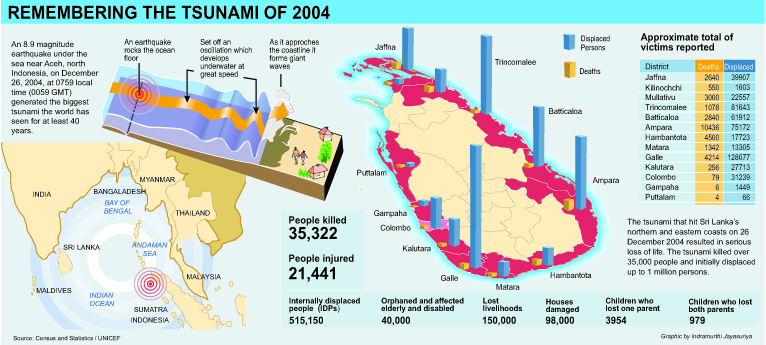
Since Mr. Emis Singno’s house collapsed a few months ago he has been trying to salvage materials from it to build a new house.
He and his wife moved to their daughter’s house when one of the walls of his home collapsed. A few months later, the entire house came down.
Many of the occupants of the Srikadurawatte tsunami housing scheme are in a similar plight; most of the 100 houses given to victims of the 2004 tsunami are falling apart.
“The entire house has caved in. All we could salvage were a few iron bars. We sold them. We have told the Grama Niladhari about the situation,” says Mr. Emis Singho.
Not familiar with the procedure to follow up his case with the district authorities, he says he only knows that he would get some funding to build his house after the election. He has received 18 bags of cement, but does not know which politician gave them.
Like Mr. Emis Singho, Wijayamuni Sarath has also come with his family of five to his plot of land where his house once stood. He wants to clear the land, hoping to build a new house if the government gives the assistance that was promised.
Mr. Wijayamuni, who works as an office aide at the Galle railway station moved his family to the railway quarters four years ago, when his home began falling apart.
“The only thing that remained standing were the concrete poles. Everything else collapsed,” he said.
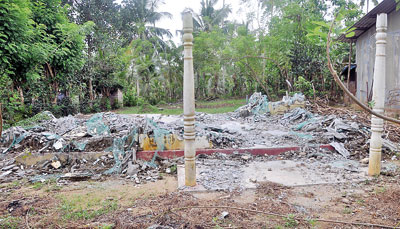
Only two poles standing: All that’s left of this house. Pix by Nilan Maligaspe
He too has received 18 bags of cement but little else. He says he has been promised funding and materials after the elections.
Neither Mr. Wijayamuni nor his neighbour, Sugath Primal, whose house has also fallen down, understands why the government is taking long to address the issue.
“We told the Grama Niladhari when the houses collapsed but four years on nothing has been done. We were told that they would give us money through the Deyata Kirula development programme next year,” Mr. Wiyayamuni said.
The residents do not really know who built the 160 houses for them.
The houses are about 740 square feet with two rooms of 120-130 square feet each, a small living area and a bathroom. They lack kitchens and the building is suitable for cooking on the wood-burning stoves these residents use. Almost all the families have built huts outside their homes to use as kitchens.
The walls are not strong. They are four-inch-thick slabs of a concrete-like mixture held in place by a thin mesh. In many of the houses these boards are coming apart, and give when pushed. Some walls have collapsed completely.
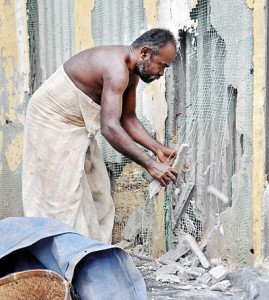
Nihal Lalith de Soysa
The decaying walls give off dust that, it is claimed, is toxic and has caused a skin rash in at least one person. District Secretariat officials confirmed to this paper that several people had told them that toxins from their houses had made them ill.
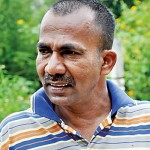
Wijayamuni Sarath
The iron rods that hold the roof and house structure in place is corroding in all the houses. The roofs in some houses have completely given way.
About 40 houses have been reconstructed with the help of a donor.
In terms of ownership, many residents merely have a letter stating they have been awarded the house. Many say they were to get their deeds later. A few community leaders have been representing their concerns to the authorities but with little success: promises given by politicians have not been fulfilled.
There are no records of the housing project, Galle District Secretary Ravindra Hewawitharana said. He is not certain who was responsible for building the houses.
“The unit that was handling the projects has been wound up and files have been handed over to the Divisional Secretary but that office doesn’t have them,” Mr. Hewawitharana said.
“According to information we have collected the materials used were suitable for cold weather but not for a tropical country,” Mr. Hewawitharana said.
“One person told me that the houses were built as a temporary measure, not permanent.”
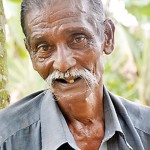
Emis Singho
The residents, however, reject this claim saying no documents issued to them state that the structures were intended to be temporary dwellings.
According to Mr. Hewawitharana, despite numerous attempts by local and provincial authorities to take the matter up higher with the government, no ministry was ready to take on the responsibility.
The National Housing Development Authority did not want to build the houses free of charge, but was willing to give assistance to the residents in terms of a loan scheme.
The residents, many of whom are working as daily-paid casual labourers, did not take up this offer as they feared they would not be able to pay off loans.
Mr. Hewawitharana claims the houses would be rebuilt at state expense under the Matara Deyata Kirula programme scheduled for next year.
“But it all depends on the politicians in the area. Their recommendations are given priority,” he said.
Some houses have been unlivable for years. Those residents who are able to move out have done so as they are concerned about the danger the houses pose. Some made a fast buck by selling out to unsuspecting buyers.
Nihal Lalith de Soysa was one such buyer. A former fishmonger who lost inthe tsunami the motorcycle he used for transport, he now sells onions at the local market.
He bought the house five years ago for Rs. 200,000 from the owner. Since then the entire house except for one wall has collapsed.
His youngest daughter, aged four, developed a skin condition and he says doctors had told him that the illness had been caused by toxic dust coming off the house walls.
The family of 10 now lives in a small temporary shed built next to the site of the earlier house.
Mr. de Soysa and his sons are now busy salvaging the stones from the original foundation to build a new house. He is faced with problems over obtaining any assistance to rebuild the house.
“When I wanted to obtain assistance I was told I could not get anything as I was not the first owner and so was ineligible for help,” he said.
Mr. Hewawitharana admits that there is no uniformity in the grants and asset transfers made to tsunami victims at the time the houses were handed over to beneficiaries.
In the Godagama Tsunami Housing Scheme of close to 500 houses, where most of the tsunami victims from the Peraliya area are settled, a similar situation has arisen.
The roof structures of some houses are falling apart. Many residents claim the quality of housing is not up to standard. None of the houses have kitchens suitable for wood-burning stoves. Those who are financially capable have repaired and remodelled the houses while others with limited incomes are in despair.
Kommbu Lalitha, a resident, said she was unable to repair her roof. She and her two daughters earn a living by weaving coir ropes while her son works on a fishing trawler out for stretches of days.
“This is going to fall down on us any time as it is badly damaged,” she said, pointing as a large insect flew into a blackened hole in the main roof beam.
The Norochcholi Tsunami Village in Akkaraipattu in the Ampara district, a housing scheme of 504 dwellings complete with all facilities including a school, remains empty even 10 years after the disaster.
Disputes between the three ethnic communities regarding the allocations of houses built with funding from Middle East countries resulted in the matter being taken to the courts.
“The court ruling directed the District Secretary to allocate the houses among tsunami victims according to the population ratios of each community in the Ampara district but one community here wants the village for themselves,” claimed Ven. Sanapathiye Ananda Thera, chairman of the North and East Sinhala Organisation.
Ven. Ananda Thera took the lead in filing the Supreme Court case against the housing allocation in 2007 when discussions with the District Secretary failed.
The responsibility of allocating the houses lies with the District Secretary Neil De Alwis. Attempts by the Sunday Times to contact him failed.
(Please see Plus cover also)
| Japanese aid crucial to recovery By Aviral Mishra Many women found themselves widowed and on the edge of survival when their fishermen husbands, who were the family breadwinners, were swept to their deaths in the 2004 tsunami. Coming to the aid of these unfortunate women, Sobokantha Parasarika Padanama, a women’s organisation, set up a dried fish project with Japanese technological and financial aid to help resurrect the livelihoods of these women. “At a cost of about $2.5 million the Japanese helped us to set up 30 furnaces for the process of drying fish,” said the organisation’s president, Nilmini Mudalige. “These furnaces maintain quality, avoiding the risk of the degradation that occurs when fish is dried in the sun.” Japanese-aided reconstruction of schools, offices and other important buildings devastated by the tsunami was carried out so that the buildings could withstand the impact of waves in a future calamity. Such projects include the Deepankara Primary School in Tangalle, Kumara Kasyapa in Kuleegoda, Vigneswara Vidyalaya in Ampara, Dikwella police station in Hambantota and Aliyawalai in Jaffna. The Japan-based Department of Meteorology (DOM) has helped the Meteorological Department set up better weather forecasting systems. The Chief Advisor of the DOM project, Masahito Ishihara, said $40m had been given to invest in more advanced equipment, and technical training was also being provided. With disaster management being a crucial part of Sri Lanka’s development agenda, Japan has also helped in risk assessment, loss mitigation and post-disaster recovery programmes. With technological and financial help a three-step process for prevention is being taken. “We have identified Kandy, Matale, Nuwara Eliya and Badulla as chief landslide-prone areas. We conduct aerial surveys of any landslide-affected areas and prepare mitigation reports if possible,” he said. Mr. Handa stated that reconstruction of landslide-affected regions in Peradeniya was a crucial disaster mitigation project, costing some $58m. Survivors stumble on with bleak lives Lalitha de Silva lost her younger son, the sole breadwinner of the family on the day of the tsunami. Her older son, who was suffering from a heart disease, went to identify the decomposed body when it was found a week later. Tragedy followed the family: the elder son died four months later, unable to bear the shock of the loss of his brother. 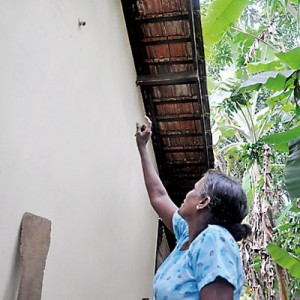 Lalitha points to the roof of her house “My younger son saved 18 people before he was caught by the second wave,” said Lalitha, tears streaming down her face. Lalitha, 55, now lives with her sister, Neetha Tillet, in her house in the Godagama Tsunami Housing Scheme which is in a similar condition to the homes in Sirikadurawatta; the roof might collapse at any moment. Her daughter, who was working in Saudi Arabia, came home to find that her that her husband had absconded with the money she had been sending home to the family. Today all three women live on the income they gain by weaving coir rope. A heart patient herself, Lalitha is not able to contribute much to the work, and worries about what the future holds. “My daughter wants to go back abroad as there is no other opportunity here. But I am worried after what has happened to her already,” she says. Galle District Secretary, Ravindra Hewawitharana said there were no specialised programmes for the needs of elderly people affected by the tsunami. He said mainstream programmes to help elders in need were able to help people such as Lalitha de Silva. Veronika Chamindi was only nine when the tsunami hit her coastal community in 2004. She lost her mother, two other aunts and her grandmother to the waves. She was taken into the care of her only living aunt. Her father, who works abroad, has abandoned her. The shock of the tsunami and loss of her mother changed Veronika, says her aunt, Seetha de Silva. “She was never able to do well in school after that. She failed her school exams and now stays at home with no job,” she says. At present, the family is stable: Mrs de Silva’s husband works as a security guard and her son is a fisherman, but the aunt worries about Veronica’s bleak future, with no employment prospects or skills to sustain her. |

